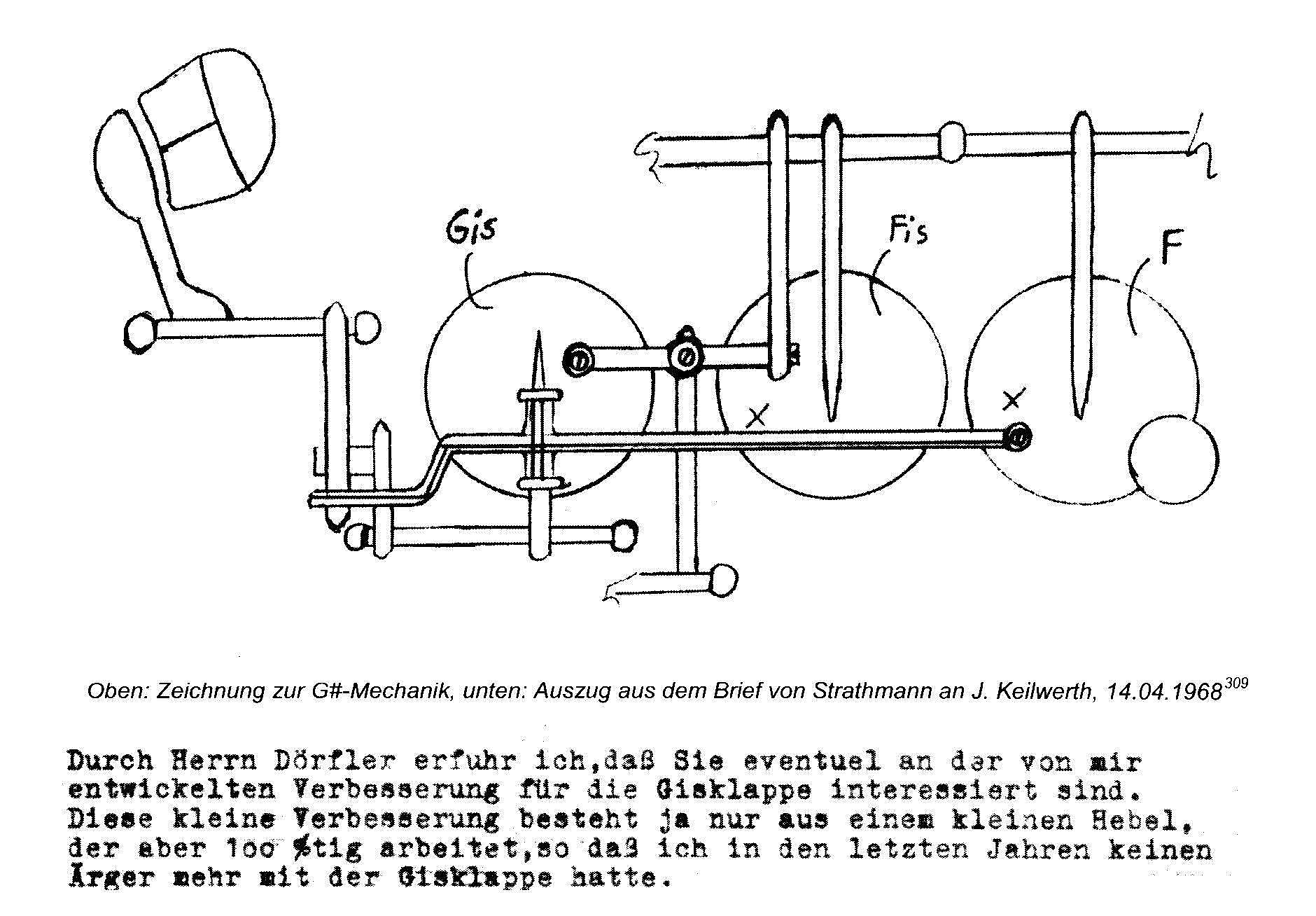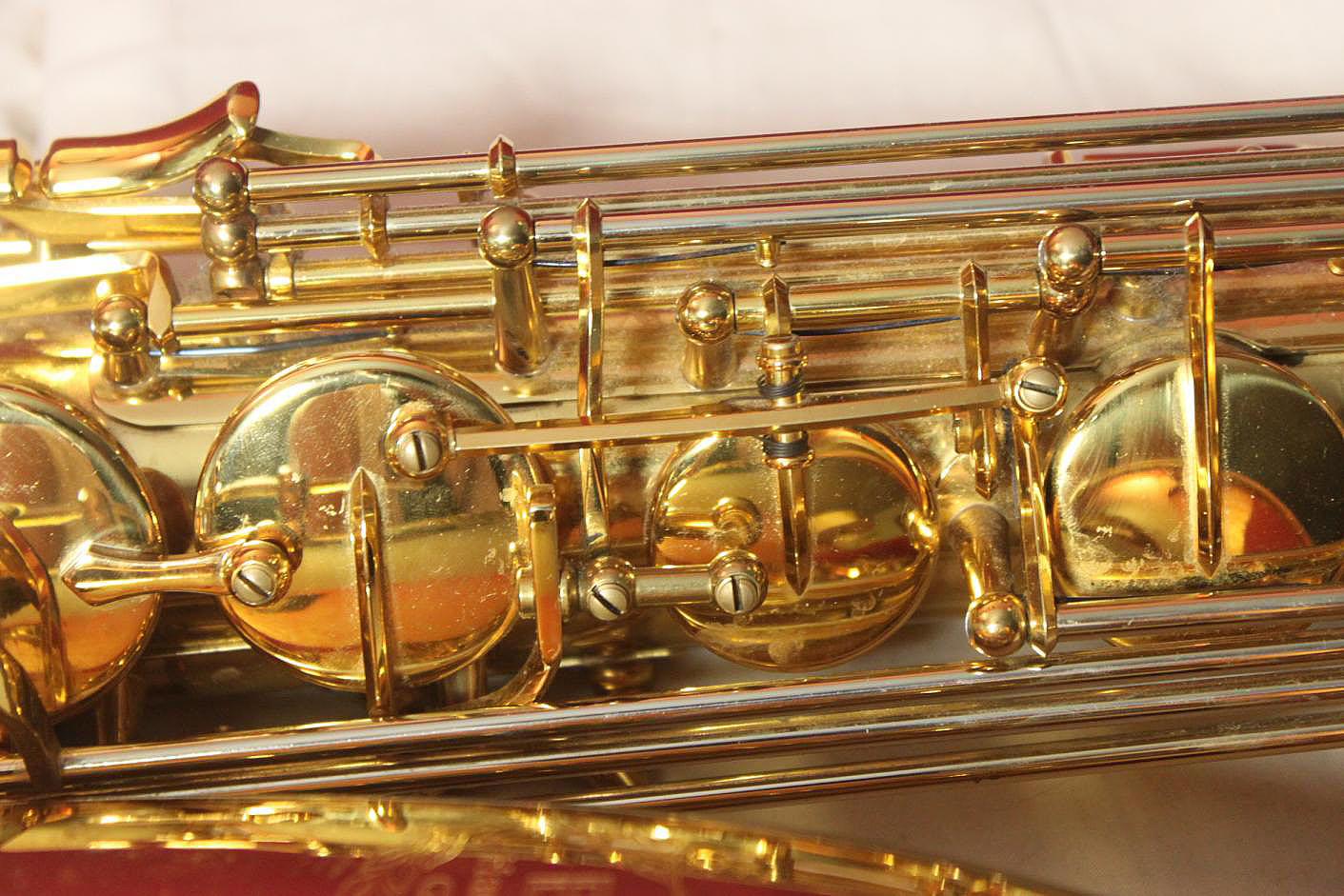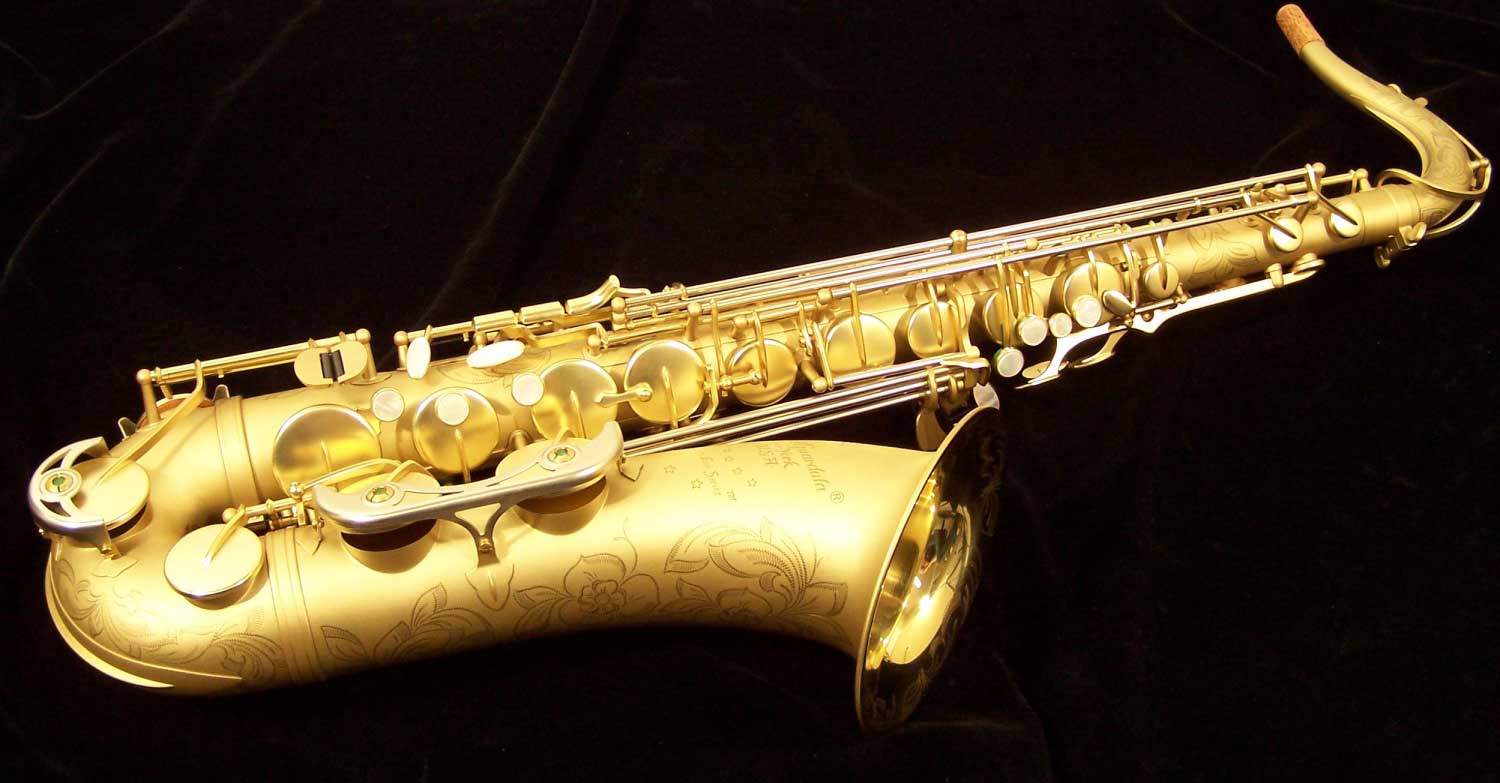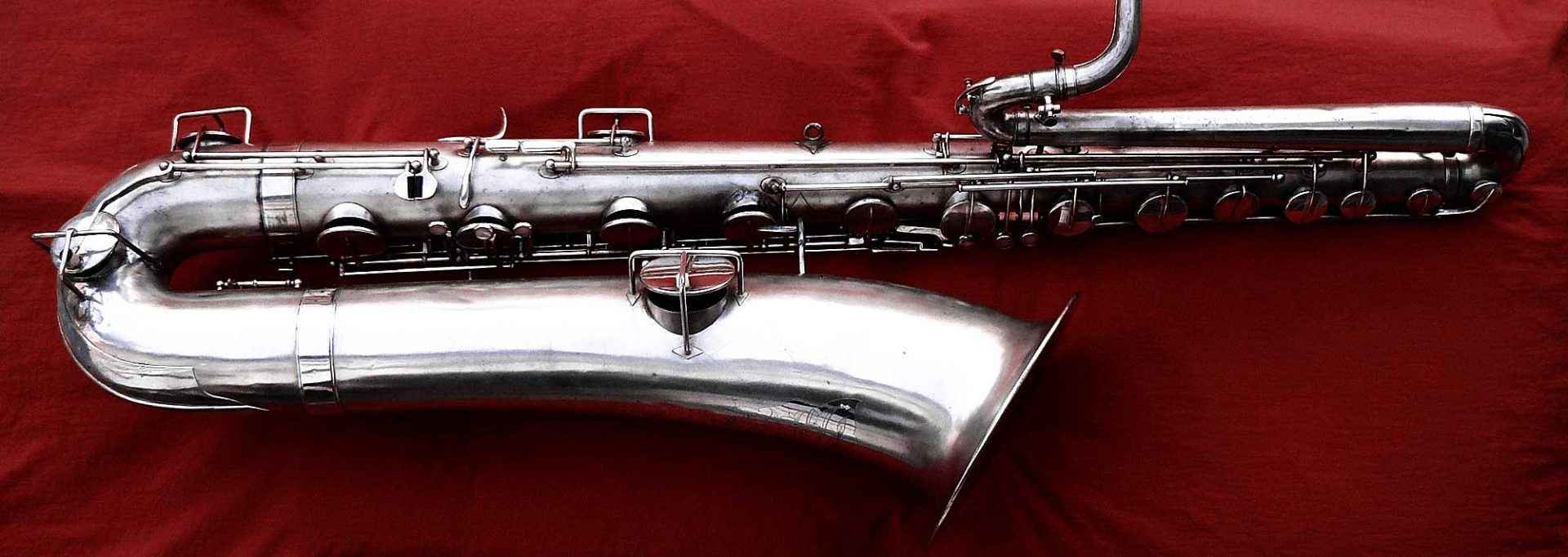Unless you’ve read Uwe Ladwig’s book, Saxofone: Ein Kompendium—which requires you be able to read German—or you have read any of the modern B&S pages on my website, there is likely no reason that you would have heard of the Strathmann non-stick G# key. It is arguably one of best, overlooked inventions of the 20th century for saxophones.
If you’re a saxophone player, chances are you have however, suffered from sticking keys. One of the worst offenders is of course the G# key. Maybe you’ve wondered why someone hasn’t invented something to prevent this key from sticking. As it turns out, some did.
The man’s name was Arnfred Strathmann, and in 1968 he proposed a non-stick G# key to Julius Keilwerth. (BTW, Strathmann was the inventor of the original Strathon sax and clarinet MPs, which have been made in a modified way for SATB saxophones by Zinner since 1973 1)
The original Strathmann non-stick G# key

The German text reads as follows:
Above: Diagram for the G# mechanism. Below: Excerpt from a letter from Strathmann to J. Keilwerth dated April 14, 1968 309.
Through Mr. Dörfler I found out that you might be interested in my improvements for the G# key. The small improvement consists simply of a small lever, but one that works with 100% dependability. It works so well, that over the last few years I have no longer had any problems with my G# key.
This simple modification that Arnfred Strathmann made to his saxophone sometime during the middle of the last century, and explained to Julius Keilwerth in 1968, was not implemented in any JK saxophone ATT. Why?
Could the two men not come to an understanding in price? Did Julius not see the value in such a non-sick mechanism for the G# key? Did Julius think he could come up with something better?
Whatever the reason, it would be 1990 before JK offered an unrivalled rocking mechanism, with a with substantial rearrangement for the annoyingly-sticking G# key.

JK had the market cornered on non-stick G# keys for all of seven years. Then in 1997 B&S introduced their Codera line, which was a joint project with Wolf Codera. They too had worked at designing an non-stick G# key for their horns…

Later B&S models (the 2001 and Medusa) would have this non-stick G# key mechanism. The Dave Guardala Series was the only model of pro horn that B&S made that did not have this modification.

When you compare/contrast the B&S vs the JK non-stick G# key mechanisms, you’ll notice that their designs are rather different. Perhaps B&S and Wolf Codera were trying to either improve on JK’s design, or reduce their chances of being involved in possible legal hassles because of design infringements.
A quick, and certainly not a thorough patent search, did not produce any results for an anti-stick G# key. Although Arnfred Strathmann, Julius Keilwerth, and Wolf Codera all have patents to their name (and Codera and Strathmann have a joint patent on a key design) not one of them appears to have patented a non-stick G# key. Really? I wonder why this is?
Patent issues aside, if you compare either the JK or B&S-designed non-stick G# key versions to the Strathmann original, you should immediately see a difference: The original was intended to go all the way to the F key, but both JK and B&S stopped theirs at the F#. Again, I have to ask the question: I wonder why?
Modern Horns with a non-stick G# key
Now I freely admit that I know virtually Jack about modern saxophones. Whenever someone asks me something about them, I have to do some serious research to answer intelligently.
When I began this article, I started to wonder: How many of today’s horns have a non-stick G# key? I can’t think of any that I’ve tried. (And honestly, I haven’t tried more than 10 or so brands in recent years, so that’s not a very big sampling.)
So with my Googling skills all primed up, I came up with the following list of modern/new saxophones that utilize a non-stick G# key:
- Certain Steve Goodson models
- Certain JK models
That’s it. That’s all. I happened across one or two others—Asian stencil horns that used the feature for a while, like Antigua’s Pro One, but have since dropped it—but none of the other big name manufacturers like Selmer, Yani, or Yamaha seem to utilize a non-stick G# key in their designs. Again, I have to ask: Why is that?
Since Asian stencils are so varied, it is quite possible that one or more of the seemingly countless name-branded horns ( eg: P. Mauriat, Trevor James, MANTRA, Kenny G, etc, etc,) that have their saxophones manufactured in maybe Taiwan or China, might have requested a non-stick G# key be added to their saxes. However, without going to each company’s website and reading through the specific specs on each model, it would be impossible to say which, if any, models have this feature.
Why? That’s really the theme of this article
This article has posed just as many questions as it’s answered. In fact, the heart of each of question has been: Why?
Given that sticking pads have likely been an issue since the saxophone was invented by Adolphe Sax more than 175 years ago, why is it that it took about 120 years for someone to come up with a solution for the notoriously-sticking G# key? And why haven’t saxophone companies all jumped on this proverbial bandwagon, and designed a non-stick G# key for all models of their saxophones?
I guess in the end saxophone manufacturers figure players can deal with a sticking G# much like the deal with a sticky low Eb: by cleaning the pad. Perhaps they felt they could get more bang for their buck by putting their money into high G keys, or altissimo vents, or threaded tenons, or semi-precious stones on the nodes, or whatever else people are seemingly willing to spend their hard-earned money on.
Personally, I would trade all of those things for a single non-stick G# key. How about you?
__________________________________________________________________________________________
1Saxophone: Ein Kompendium, by Uwe Ladwig. Second edition 2012, p. 159.



Hi I know this thread is ANCIENT but I want to mention that Cannonball seems to have had a pretty elegant solution. It wasn’t 100% foolproof but they installed a small leaf spring on the G# key that lifts the side arm on the pad cup from below. I think they call it a double-sprung G# key. The other Big 4’s seem to think “we use good pads on our horns so that isn’t necessary”
Huh, didn’t know Cannonball had that. I will have to look into that a bit more and find out what it is exactly and which models have it.
As far as the “big four” you mention not having such a mechanism, I am assuming you are counting Keilwerth into this? If so, remember Keilwerth does indeed use use what they call a “G# lifter” on their SX90R saxophones. It is Selmer, Yani, and Yamaha that to the best of my knowledge anyway, have never had any way of addressing the stickiness of the G# key.
The Eb key is easily the hardest pad to prevent from sticking due to it’s position on the instrument, but even if it does stick, you can still just pash down hard enough to get it to come up because it isn’t a spring pulling up on the key, it is your finger so this doesn’t seem as big as a problem as the G# key. The G# key is a problem because you push the key and that doesn’t move the pad, it simply allows a spring to move the pad which can be problematic if the amount of force needed to move the pad is greater than the amount of force the spring can put out.
One of the first rules in engineering is, avoid narrow tolerances.
As the saxophone completely ignores this rule, some saxophone designers
think they have to avoid a second rule; to solve problems as near to the source as possible.
The result of this policy is a design with more moving parts, more tension on the springs,
more narrow tolerances and a slightly heavier mechanism, topped with a small change in sound.
Selmer, Yanagisawa and Yamaha use this second rule correct and treat it as a pad problem, that should be solved by pad designers.
Arnfred Strathmann choose to put the extra tension on the spring of the F key, his solution has the most metal and weight.
The JK approach uses the F# key spring. The disadvantage is that it also affects the D, E and F key.
I can not choose which is the better solution.
Now back to the source of the problem.
The long protein chains in hide make excellent leather for pads.
When hide is spoiled, pockets of smaller proteins form, which are an excellent glue.
It is not possible to avoid all glue pockets in leather pads.
So, if your G# pad contains this glue, moisture will leach it and your pad gets sticky.
Silicone layers on leather pads are used to slow the leaching process.
Not a complete solution, but it helps.
A more direct solution is to avoid leather.
I have no sticking problems with my silicone/mdf pads when installed properly.
Gold pads should also be non sticking.
And maybe one of the many leather substitutes will work.
I’m not at all convinced that leather is the best material for pads. There are so many new materials available these days, you would think that at least one of them would be suitable as a leather substitute. You have already mention one: silicone. I’m sure there are others as well. The Vibrato sax must use something waterproof as well. I just can’t recall now what it is.
That said, musicians are somewhat traditionalists, and don’t take kindly to change. I would like to see a company like Selmer partner with a pad company and put a truly non-sticking, synthetic pad in at least a couple models of their horns. This would at least get people talking about the concept.
The industry offers new material pads on all other woodwinds.
Saxophones are far beyond bassoons and clarinets in high tech materials.
The most successful saxophone adaptation is a synthetic octave pad.
Clearly the law of the handicap of head start is correct here (another Dutch invention).
Saxophone players need to realize this and start to have a more open discussion on the use of new materials.
The industry could help here.
Do not forget that Selmer provided the synthetic O-rings for the padles, successfully used non-blue springs
and has the patent on which the top tone pads, the Codera discs and the vibrato sax pads construction are based.
How about encouraging players to wedge or clamp the Eb, C#, and G# keys open when they put the horn away, or even down for a while? This at least would decrease the opportunity for them to get sticky in the first place. I’ve known some people to slip a folded dollar bill under each of those pads before putting the instrument in the case, though I admit to not being one of them.
(This might not be so attractive to Canadians, where the smallest bills are fives, but you do get the money back.)
Prevention is a good thing, but the clamps and wedges should not give pressure on the pads.
Using bills can be awkward for musicians as it takes approximately 13 bills for each saxophone to cover all closed pads.
When the bills are new it is possible that they stick to the pads.
So use old bills, or English pounds which are made with non vegan grease.
Old French bills made of hemp paper are excellent.
A non paper method is celluloid.
It looks like plastic, but it absorbs water.
Clamps could be applied to the mechanisms and touches and not make any contact with pads.
Also, I deliberately left out the palm keys, side keys, etc. because none of those are opened by opposing springs. It’s direct lever action. You press the touch, and either the key opens or the touch doesn’t move much. The amount of force transmitted is also much greater, making a total stick less likely. You can, of course, shred pads by forcing them when they’re stuck, but by that point they need replacing anyhow. (Not that it’s a good thing to do during a gig!) The low Eb is also a direct lever, but is in a spot that almost ensures it will get wet. I’m not sure it’s necessary to wedge low C# — while I’ve had it stick, popping it once by hand has been sufficient to make sure it doesn’t stick again, so adding a quick check to the warmup routine should take care of that.